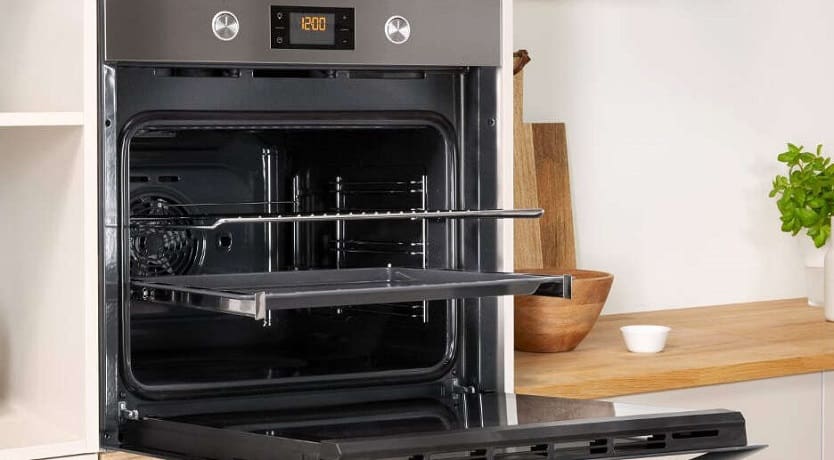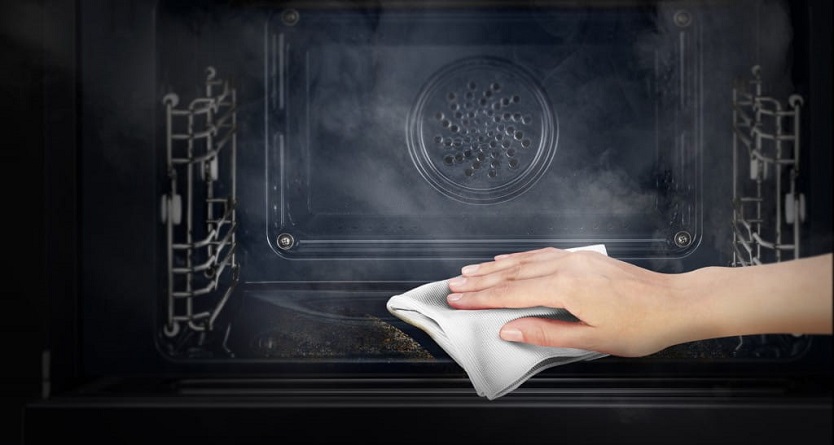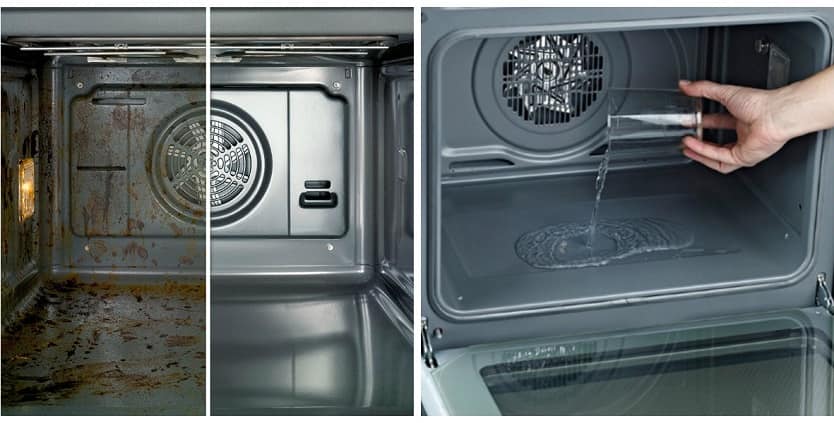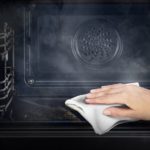Hydrolysis oven cleaning occupies a special place among the various ways to eliminate contamination in ovens... First of all, in comparison with other methods of dealing with dirt in the oven, this method is the fastest and least expensive. Below we will consider what this method is, how to use it and what types of hydrolysis cleaning are.
What is hydrolysis oven cleaning

Features of hydrolysis oven cleaning, what it is and what the process is based on, becomes clear from the meaning of the word "hydrolysis" itself, which can be translated from Greek as "decomposition by water". More precisely, steam - water in the oven, under the influence of temperature, turns into a vaporous state. Steam, acting on grease and other mud deposits, softens them. After that, it is much easier to remove them from the inside of the oven using a sponge or cloth. A type of hydrolysis cleaning can be considered the use of a steam generator, which produces a steam jet with a temperature of about 150 degrees. Hot steam treatment of the surface makes cleaning the kitchen much easier.
See also:
- 6 best ovens VECO 2019
- 7 best Korting ovens according to customer reviews
- The 8 best Hansa ovens of 2019
- Hotpoint-Ariston's 8 best ovens
- The 8 best ovens in Gorenje
How to start hydrolysis cleaning

To carry out hydrolysis cleaning of the oven, you must:
- Remove the runners and trays from the oven.
- In new models of electric ovens, in which the design provides for the function of hydrolysis cleaning, there is a special recess in the bottom that must be filled with water. However, you can put an enamel bowl or baking sheet with water inside, because cleaning the oven with hot steam can be used for almost all types of ovens - both gas and electric.
- Turn on the oven, setting the temperature in the range of 50-90 degrees (the exact value can be found in the instructions for use).
- Wait 3–40 minutes. During this time, the hot steam will interact with the dirt and grease particles. The dried fat will absorb moisture and begin to drip down the sides of the oven.
- Unplug the oven and let it cool down.
- Then finish cleaning by wiping the inside of the oven with a cloth or washcloth. It is best to use non-abrasive cleaning agents.
Important:
Do not use cleaning powders - they can damage the enamel, and subsequent hydrolytic cleaning can provoke the appearance and development of corrosion.
To enhance the effect, you can use special gels that are added to the water. Manufacturers indicate the list of recommended agents, as well as their concentration in the instructions for use. However, it is possible to increase the effectiveness of the effect of steam on oily stains using traditional methods, for example, adding vinegar to the water (in proportion to 2 parts of water and 1 part of vinegar), lemon wedges or table salt.
![]() See also - How to quickly clean the oven from grease and carbon deposits
See also - How to quickly clean the oven from grease and carbon deposits
Varieties of hydrolysis cleaning

Modern models of ovens have more advanced options for hydrolysis cleaning of the inner surface - the Cleaning and Aqua Clean functions. In the first case, instead of water, a special spray is used instead of steam. The oven is heated to 90 degrees, after which it is necessary to open the door and carefully, so as not to burn yourself, spray everything inside the oven with a spray bottle. Close the door and wait another 15 minutes, turn off the oven and let cool. Then collect the remaining fat with a sponge or paper towel.
Aqua Clean allows you to clean with steam in a gentle mode, at a low temperature, while the oven does not heat up over 50 degrees. Premium segment ovens have special hydrolysis programs. They enable the user to independently choose the temperature regime and duration of the cleaning process.
Advantages and disadvantages of hydrolysis treatment
The pros and cons of hydrolysis oven cleaning are associated with the use of steam - this makes the process very cheap. In addition, there is no need to preheat the oven to a high temperature, which saves electricity and makes this decontamination option even more cost effective. It should be noted that the process can be carried out without the use of chemicals.
However, there are a number of quite serious shortcomings:
- First of all, hydrolysis cleaning does not fit the definition of "self-cleaning", because to obtain the final result, you will have to manually wipe the surfaces from the fat split by steam.
- Hot steam is a rather aggressive environment, therefore, before carrying out hydrolysis cleaning, you must read the instructions, whether the manufacturer recommends it. The use of cheap coatings and low-quality metal in low-end ovens can provoke surface damage, which over time will lead to rust.
- Hydrolysis cleaning is ineffective when it is necessary to remove stubborn or difficult stains. Over time, under the influence of temperature, the fat dries up and changes its structure, which greatly complicates cleaning with steam. It may be necessary to repeat the procedure several times - after hydrolysis cleaning, manually remove the grease stains, and then repeat the operation. It is most effective to carry out hydrolysis cleaning immediately after cooking, after allowing the oven to cool down.
Compared to other methods - catalytic and pyrolytic - hydrolysis oven cleaning is the least effective and requires more manual labor. But at the same time, it is the simplest in terms of technical implementation and the least expensive, therefore it is actively used in models of leading manufacturers of household appliances, for example, Electrolux or Bosch.
See also:

